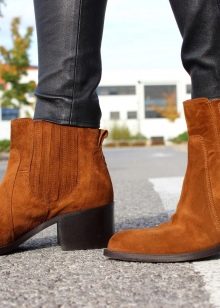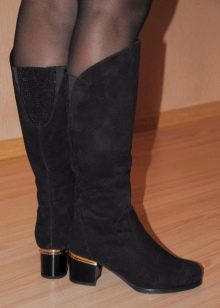Suede shoes are an indispensable attribute of any fashionable wardrobe. Not only bags and clothes are made of this material, but also shoes, autumn boots, warm winter boots, which are distinguished by a wide variety of models. However, despite the attractive appearance, suede is capricious and will not forgive improper care for her.
Material Features
Suede is widely used in the shoe industry. Even sports shoes, sneakers and light sneakers are made from it. In appearance, the material can be:
- artificial;
- natural.


Faux suede is a synthetic material. It can be made in two ways.
In the first case, particles of pile are glued to the base, lubricated with a special adhesive. This method of making suede is considered the most economically inexpensive, but the quality of the finished fabric leaves much to be desired. Shoes made of such material will not last long.

The second method allows you to get better suede. For this, microfiber threads are fluffed, thereby turning into an analogue of natural suede. Such shoes look expensive, and in the care does not require special subtleties. The only disadvantage of faux suede is its cost, as its high quality is certainly reflected in the price.

Natural suede is made from the skin of animals, usually small breeds. The fluffy surface of the material is treated with various vegetable oils or animal fats, which allows the shoe to be water-repellent.

There are two ways of making natural suede.
- Using a cutting machine.With this method of production, the skin flap is divided into two parts on a special machine. The inner layer is fluffed and allowed to sew products from suede.
- The skin flap is carefully turned out and polished on the wrong side. Products made of such suede are most valuable, as they have two sides, one of which is represented by smooth skin.


Shoes made of natural suede are resistant to aggressive external factors. She is not afraid of exposure to alkali, acids and salts. It withstands temperature extremes, comfortable to wear in harsh winter conditions.

How to choose the right suede?
If you want shoes to serve more than one season and look expensive and presentable, then not only care is important, but also the initial right choice of material. It is better to give preference to natural suede, and to distinguish it from artificial, you need to pay attention to some factors.
- Smell. Natural material will always have a skin odor, while imitation will smell like glue or any other foreign chemical.
- Surface. A smooth and perfectly even surface usually has only artificial material. The natural one has a porous structure, various irregularities and minor defects that indicate a method of treating the skin.
- The basis. Natural suede has a terry structure on both sides, and artificial suede has a fabric base on the wrong side.
- Genuine Suede the villi slightly change color if you hold them by hand.
- Price is too low. Natural suede cannot be cheap by definition, so at a low cost you should know that, most likely, shoes made of artificial counterparts are purchased.
- The edges of the product. Not bent and untreated seams indicate that the product is made of natural material, as it does not crumble and does not need additional processing.



Genuine suede shoes give you maximum wearing comfort. Her legs do not sweat, "breathe." Artificial material cannot boast of such qualities.

The subtleties of care
In order for suede shoes to serve more than one season, you should carefully and correctly care for it. Particular attention should be paid to the first treatment (especially in autumn, winter and spring) with special means, which is carried out immediately after buying a pair at home. To do this, you should purchase a protective agent (usually in the form of a spray), which allows you to create a transparent film that will prevent the shoes from getting wet. And also this will avoid the negative influence of salts, which cover the roads of cities in the winter. In order to achieve the best water-repellent properties, some shoe manufacturers recommend impregnating the shoes several times.

Attention! Before applying the next layer, you must wait until the previous one has completely dried.
The following stages of care are performed at regular intervals, some of them daily.

Cleaning
In order for a pair of shoes to maintain a presentable appearance for a long time, it is necessary to conduct daily cleaning from pollution. To do this, you can use both improvised ("folk") means and store lines to care for products made from this material. Shoes can be cleaned with:
- gasoline;
- regular eraser;
- ammonia;
- steam bath;
- special equipment.
When using gasoline, you should only use one that has a high degree of purification (for example, which refuel lighters). With this tool, stains from grease and fuel oil can be removed from shoes. To do this, wipe the contaminated area with a clean cloth soaked in gasoline and leave it to soak for 15 minutes. After that, the treated area is sprinkled with coarse salt and after a few minutes, carefully remove it with a brush. If necessary, this procedure can be repeated several times until a satisfactory result is achieved.


A regular school eraser can save suede shoes from shiny areas. To do this, rub it with a shiny area until the gloss completely disappears.

Note! The eraser must be clean, free of traces of paint and a ballpoint pen, otherwise you can easily mess up your shoes even more.
Ammonia is a unique product that is widely used not only in medicine, but also in everyday life. To clean suede shoes with it, you need to mix it with water at the rate of 1: 3, and apply the resulting composition to pre-dusted shoes. Leave on for 15 minutes for exposure. If necessary, you can repeat the processing.

Steam cleaning is also very effective for suede, both natural and artificial. You can use a steam generator, or hold shoes over boiling water, and then carefully comb with a special brush.

Special creams for suede shoes care include special creams that are applied to shoes and remove even the most persistent stains.


Color recovery
Periodically, any suede shoe needs tinting in order to return it to a saturated color and paint over faded areas. For these purposes, shoe paints for suede are used. When working with them, you should adhere to the recommendations of specialists.
- In order for the shoes to dye evenly, it is necessary to choose the paint exactly in tone. It can be purchased at specialized shoe or clothing stores.
- Before staining, you should try the paint on an inconspicuous area (inside the shoe).
- The procedure itself should be performed strictly according to the instructions of the paint manufacturer. For ease of application, you can use a brush or foam sponge.
- After the three hours necessary for the applied paint to dry, you need to walk along the shoes with a brush to raise the lowered pile.

Note! The easiest way to dye black and gray suede. The most capricious are beige, cream and white shades, since it is very difficult to guess the tone of paint with them.
Washing
Suede is a very delicate material, especially if it is natural, so it is better not to bring such shoes to normal washing, limiting yourself to daily thorough care. However, in the case of serious pollution (or very light shoes) can not do without such extreme measures. If you wash according to the following rules, you can avoid the negative impact on the appearance of the shoe.
- No need to wet shoes from the inside. Shoes should never get wet through. For this reason, machine wash is prohibited.
- It is not recommended to use powders for washing, as they are poorly soluble in water. It is better to give preference to liquid detergents.
- Handle shoes better with a foam sponge dipped in soapy water. It is better to use rubber gloves to protect your hands.
- Washed shoes should be tightly packed with newspapers and left to dry at room temperature.


Attention! Suede shoes must not be dried in the sun or on heating appliances, as they may become deformed or form stains on the surface that will be difficult to remove.
Proper storage
The life of the shoes also depends on how the shoes are stored, so you need to pay special attention to this moment. During storage (especially in the summer), a number of rules should be followed.
- Do not fold the bootlegs, since horizontal creases are formed, which then will be impossible to remove. Stuff boots with newspapers, or use special inflatable or foam forms for the bootlegs.
- It is optimal to store shoes in a cool place away from sunlight and heating appliances.
- Before storage, the shoes must be cleaned of dirt and thoroughly dried, otherwise mold may appear on it and the steam will be spoiled.

Care Product Rating
Here are the most popular industrial products for suede.
- Color restorer. Allows you to return the shoes to their original appearance. It can be produced in the form of emulsions, sprays and creams.
- Water repellent impregnation. Allows to protect shoes from moisture. More often they look like a spray or a light emulsion.
- Stretchers Used to “fit” shoes in size. Most often you can find on sale in the form of foam.
- Impregnation. Enhances the natural protective properties of suede. Available in the form of sprays and creams.


The most popular manufacturers of suede shoe care products are: Salamander, Always Dry, Tarrago.
Suede shoes do not lose popularity due to their beauty and comfortable to wear. And despite the fact that she is very capricious in leaving, if you do everything on time and follow the recommendations, then such shoes can be used for more than one season.
You can watch how to care for suede in this video.





